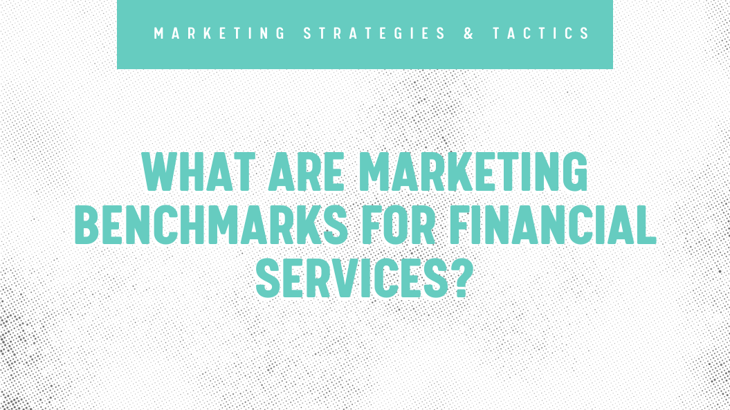What Are Marketing Benchmarks for Financial Services?

Benchmarks give you a measuring stick for your marketing.
Without them, you are playing the game blind, which is a recipe for failure (and lots of wasted time and money).

It’s hard to know which marketing strategies are the best in financial advisor marketing.
What is working and what isn’t? Not only that but the role of marketing in financial services can be hit or miss.
The right approaches to digital outreach are important.
That's where benchmarks come into play.
They help you determine what you can do better in your marketing strategy by understanding what is working or not working.
You can also provide the best online experience for prospects with that information.
Let’s dive into benchmarks and how they affect you as a financial advisor.
What Do We Mean by Benchmarks?
Originally, benchmarks were used to compare and improve rifles, as marksmen were rather unreliable.
Rifles were quite literally fixed on a bench in an attempt to hit a mark accurately.
In the business sense, benchmarks are reference points or indicators of performance, like hitting a target.
Often benchmarks are measured competitively, between advisors or as industry averages.
However, benchmarking can also be an individual, internal process to build strategies and hit new goals.
Benchmarking also helps you understand where any improvements can be made, like in your marketing campaigns.

Even small registered investment advisors (RIAs) can boost performance by setting goals and benchmarking progress.
Overall, financial advisors can gain strategic advantages by benchmarking their services and outreach.
Benefits of marketing benchmarking include the ability to:
- Analyze competitive data
- Promote customer satisfaction
- Monitor campaign performance
- Increase quality leads
- Set goals and plan around them
You want to be sure to put energy into the areas that will improve your offerings.
However, as digital marketing increases, benchmarking is moving beyond analysis.
It has brought more focus to how financial services and advisors promote themselves online.
So benchmarks are goals and you can measure how you meet them.
Great! But how does that connect to digital marketing?
What Are Benchmarks in Digital Marketing?
Applying benchmarks to financial digital marketing allows you to place resources into different marketing channels.
These can be emails, blogs, or paid ad search engine results, among others.
Normally, with benchmarking, you should test your current digital marketing actions.
This includes taking notes of how often to carry out campaigns.
How much traffic do they generate?
And how effective are they?
Think about what advertising spaces give you the best return on investment (ROI).
How about your competition?
Comparing your marketing results to industry benchmarks helps you:
- Know what's working (and what's not working) to market a financial practice in 2022
- See how effective your marketing is compared to your competitors
- Make decisions about where to invest your marketing dollars for the best results
- Create a data-driven marketing plan to help you reach your growth goals
You use benchmarking to figure out what is worthy of your time and money.
It can be expensive and you don’t want to put your money in the wrong place.
This will help you build a benchmarking marketing strategy.
Snappy Kraken can help you collect the data you need.
They will take that data and apply it over different avenues of customer engagement so you don’t have to calculate alone.
They offer the ability to apply those benchmarks to financial marketing focusing on where you invest money.
The financial industry sees significant benchmarks in the following areas:
- Engagement rates on social media
-
Industry averages for social media click-through-rate (CTR):
- Facebook: 0.56% (Note: Snappy Kraken members see an average CTR of 0.67%)
- LinkedIn (across all industries): 0.27%
- Twitter (across all industries) 1.55%
- Facebook: 0.56% (Note: Snappy Kraken members see an average CTR of 0.67%)
-
Industry averages for social media cost-per-click (CPC):
- Facebook: $3.77
- LinkedIn: $6.90
- Twitter (across all industries): $0.33
- Facebook: $3.77
-
Industry averages for social media conversion rate:
- Facebook ads: 9.09% (Note: Snappy Kraken members see an average conversion rate of 13%)
- LinkedIn (across all industries): 5% to 15%
- Facebook ads: 9.09% (Note: Snappy Kraken members see an average conversion rate of 13%)
Ultimately, determining your marketing benchmarks should start with the following five steps:
- Select the digital marketing platforms you want to invest marketing resources in like email, videos, or blogs.
- Choose which metrics to measure for appropriate data. Understand how often you post, what is the click-through rate, and if your call to action is effective.
- Use benchmarking analytics tools to measure those metrics. Determine what needs to be improved compared to other businesses.
- Create a report to guide the development of a digital marketing strategy. This helps boost your metrics.
- Continue regular analysis to track improvements and develop new strategies in the future.
The good news is you don’t have to build the plan on your own!
Snappy Kraken provides you with original content relevant to your financial business.
What’s great is you can build your credibility and gain targeted clients while automating your digital marketing strategy.
This ensures you’re spending money where it counts.
You’ll have more time to focus on clients and worry less about marketing.
You’ll be able to see significant results quickly in your benchmarks by standing out from your competitors.
But why is marketing necessary in financial services?
What Is the Importance of Marketing in Finance?
Marketing is the difference between reaching new clients or only getting references from current clients.
Word-of-mouth has a significant impact on gaining new clients as an advisor.

However, it can be difficult to measure referrals.
What we do know is active digital marketing campaigns can be more effective for benchmarking.
There are a lot of financial advisors out there too, so precise marketing is important.
It all boils down to: marketing is practical.
For example, an advisor creates a series of blogs on their website.
These blogs are targeted toward retirees with large portfolios.
One goal should be to educate potential and current clients on a specific topic like diversifying investments.
But the end goal of the blog is to reach their target clientele.
After posting, they would need to focus on insights, such as views, click-through rates, and conversions.
How many serious inquiries and leads did the blog produce?
A benchmark through Snappy Kraken would allow them to see how the blogs are performing without pulling information on their own.
Automate Your Digital Marketing with Snappy Kraken
At Snappy Kraken, we’ve worked tirelessly to ensure you get the best, premium content.
You don't want the hassle of keyword research and spending on unsuccessful marketing.
You will stand out from the crowd and get your message in front of new prospects every month.
Take the guesswork out of marketing and use our proven marketing tools.
Visit our website today to see how we can help you produce quality content and drive results!
Book A Demo Today
Discover how Snappy Kraken helps advisors grow with a powerful marketing system
Request a demo

